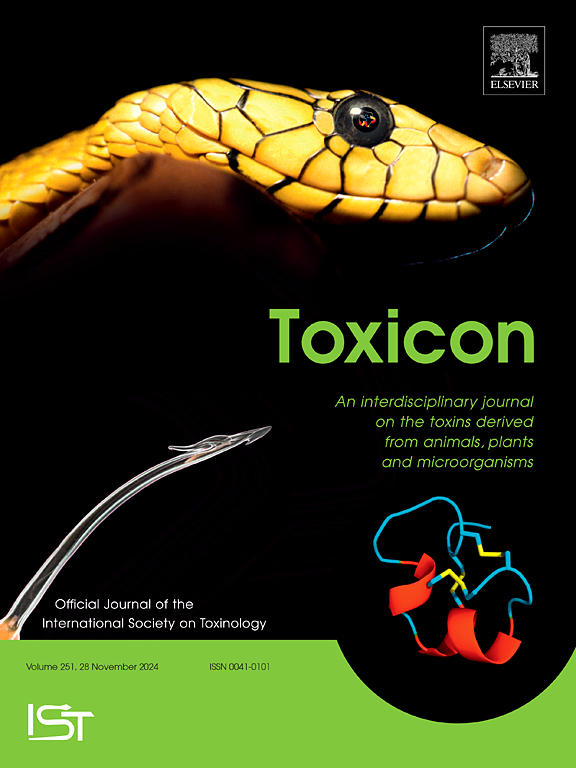柬埔寨淡水河豚体内蛤蚌毒素分布的地区差异
IF 2.6
4区 医学
Q2 PHARMACOLOGY & PHARMACY
引用次数: 0
摘要
柬埔寨的湄公河生活着大约十种四齿鲀科的淡水河豚。然而,关于这些鱼的毒素特征的信息有限。在本研究中,为了获得有关柬埔寨淡水河豚体内毒素分布的充分信息,于2019年11月(n = 23)和2023年3月(n = 21)分别在金边(PNH)和Kratie (KTI)采集了一种Pao淡水河豚(Pao sp. A)。毒素分析表明,这两个地区的个体都含有蛤蚌毒素(STXs),而不含河豚毒素。来自PNH的样品在皮肤、肌肉、肝脏和性腺中具有较高的STXs水平,而来自KTI的样品在皮肤中显示相对较低的STXs水平。PNH个体卵巢STXs数量随性腺指数(gonadosomatic index, GSI)的增加呈指数增长。我们还发现,随着KTI个体的成长,皮肤中的STXs浓度越来越高。这些结果表明,生活区域的差异可能会影响Pao淡水河豚体内STXs的分布,成熟和/或生长也有影响。本文章由计算机程序翻译,如有差异,请以英文原文为准。

Regional differences in intra-body distribution of saxitoxins in freshwater pufferfish Pao sp. A from Cambodia
The Mekong River in Cambodia is inhabited by approximately ten species of freshwater pufferfish of the family Tetraodontidae. However, limited information is available regarding the toxin profile of these fish. In this study, to obtain sufficient information on the intra-body distribution of toxins in Cambodian freshwater pufferfish, one species of Pao freshwater pufferfish (Pao sp. A) were collected from Phnom Penh (PNH) in November 2019 (n = 23) and from Kratie (KTI) in March 2023 (n = 21). Toxin analyses of these samples revealed that individuals from both regions possessed saxitoxins (STXs) and contained no tetrodotoxin. Pao sp. A specimens from PNH possessed high STXs levels in the skin, muscle, liver, and gonads, whereas those from KTI showed relatively low levels of STXs concentrated in the skin. STXs amount in the ovaries in PNH individuals increased exponentially with increasing the gonadosomatic index (GSI). We also clarified that STXs concentration in the skin became increasingly higher as KTI individuals grew. These results suggest that differences in living regions may affect the intra-body distribution of STXs in Pao freshwater pufferfish, with maturation and/or growth contributing as well.
求助全文
通过发布文献求助,成功后即可免费获取论文全文。
去求助
来源期刊

Toxicon
医学-毒理学
CiteScore
4.80
自引率
10.70%
发文量
358
审稿时长
68 days
期刊介绍:
Toxicon has an open access mirror Toxicon: X, sharing the same aims and scope, editorial team, submission system and rigorous peer review. An introductory offer Toxicon: X - full waiver of the Open Access fee.
Toxicon''s "aims and scope" are to publish:
-articles containing the results of original research on problems related to toxins derived from animals, plants and microorganisms
-papers on novel findings related to the chemical, pharmacological, toxicological, and immunological properties of natural toxins
-molecular biological studies of toxins and other genes from poisonous and venomous organisms that advance understanding of the role or function of toxins
-clinical observations on poisoning and envenoming where a new therapeutic principle has been proposed or a decidedly superior clinical result has been obtained.
-material on the use of toxins as tools in studying biological processes and material on subjects related to venom and antivenom problems.
-articles on the translational application of toxins, for example as drugs and insecticides
-epidemiological studies on envenoming or poisoning, so long as they highlight a previously unrecognised medical problem or provide insight into the prevention or medical treatment of envenoming or poisoning. Retrospective surveys of hospital records, especially those lacking species identification, will not be considered for publication. Properly designed prospective community-based surveys are strongly encouraged.
-articles describing well-known activities of venoms, such as antibacterial, anticancer, and analgesic activities of arachnid venoms, without any attempt to define the mechanism of action or purify the active component, will not be considered for publication in Toxicon.
-review articles on problems related to toxinology.
To encourage the exchange of ideas, sections of the journal may be devoted to Short Communications, Letters to the Editor and activities of the affiliated societies.
 求助内容:
求助内容: 应助结果提醒方式:
应助结果提醒方式:


